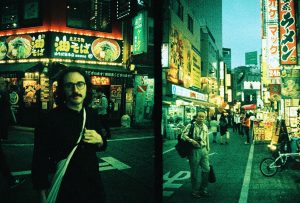Flickr link: https://www.flickr.com/gp/153140530@N03/61PsC0
As soon as I finished shooting the intriguing Tokyo sky rise in front of me I immediately began questioning if that particular photograph would turn out the way I planned, will this moment be lost due to over exposure? Was I holding the camera correctly? What exactly will this photograph look like? These are the most exciting yet nerve wrenching aspects of film photography. Many people would argue that this is superfluous yet for me, it is worth the experience and time because of the sentiment tied to film photography.
Some argue digital photography to be less interesting then film [1] however I still continue to use digital photography for its convenience. The main reasons why some find digital photography inferior is because of hardware limitations for example maximum resolutions, bit depth, lenses and how many digital cameras can be poorly designed [2]. Similar to audio tape, as mentioned in my reflective piece on sound, film has some “good” impurities. These consist of grain (which is very evident in the photographs I have chosen to present), color saturation, which is due to the film that is used and the type of camera. Another thing I find so interesting about shooting on film is how unrealistic perceptions of objects, places and people can be warped due to the crystals in the film’s reaction to light.
An important attribution to the methodology of photography is what photographers call “the decisive moment”. This is so important when shooting with film as one roll contains only 36 photographs. The photographer wants to capture exactly what is in front of them at the most optimal time. As well as capturing the photograph, most professional film photographers will spend long periods of time processing and physically editing their photos. This is a large part of creativity and demonstrates the importance of the creative process and understanding of creative thinking as a whole. Many photographers argue that digital photography does not allow the creative individual to consider or plan for the decisive moment [3]. This is solely due to the fact that using digital allows the photographer to snap as many photographs as they please without careful consideration and preparation, therefore less time and effort has gone into the creation of storytelling. Admiration for the digital photographs produced becomes less prominent rather then the physical form.
This photo series attempts to utilize the aforementioned impurities and limitations that force a photographer to preside over the photo. It also attempts to capture the beauty and organic nature of the film stock by shooting only in Tokyo and Osaka cities at dusk/night. The camera I used is an old RICOH 35mm Auto Half, half frame camera with a maximum ISO capability of 200. I used this camera because it shoots a single photograph onto half of a frame, combining two photographs together. I had to consider what photograph would appear more favorable and aesthetically pleasing next to each other forcing myself to consider the similarity of the images and tell a mini story in one photo. Because the camera has complete control of itself and is relying on its old light meter there is a high chance of miscalculations and “happy accidents”. To manipulate these properties, the photographs are taken at night with 200 ISO film to enhance the gain and intensify the already intense lights of Japanese cities.
[1] Digital photography vs. film: What works for you? Mikle, Toby. Inside Photoshop; Louisville 5.12 (Dec 2001): 11-12.
[2] Ongoing battle: film vs. digital photography. Nelson, Sally. University Wire; Carlsbad [Carlsbad]09 Feb 2012.
[3] The decisive moment photographs and words. Henri Cartier-Bresson 1908-2004. 2007




